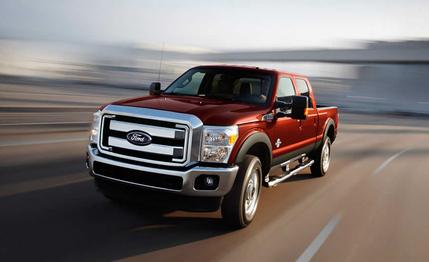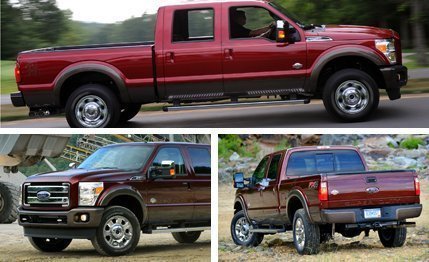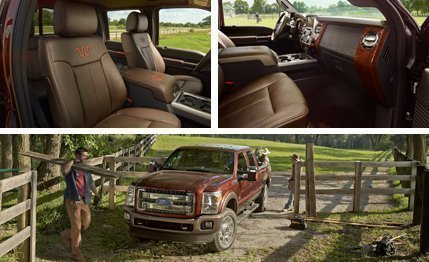 First Drive Review
First Drive Review
Pickup buyers generally fall into one of two categories: Weekend Warriors and Heavy Haulers. While the former are primarily outdoorsy types, DIYers, and recreational-minded folks with toys to tug, people in the latter group rack up many thousands of miles trailering livestock, campers, and contracting or farm equipment. Weekend Warriors usually find all the capability they need in half-ton trucks like the Ford F-150, Ram 1500, and Chevrolet Silverado 1500. Heavy Haulers, on the other hand, tend to opt for what we still call the one-ton class of trucks: Dedicated workhorses that can be equipped with dual rear wheels and torque-happy diesel engines, trucks that place payload and towing capacity at the top of their list of priorities. But there is a middle ground, and in the Ford Trucks lineup that ground is occupied by the F-250 Super Duty.
It’s said that familiarity breeds contempt, but you’d never know that by the essentially unchanged interior and exterior of the F-250, which was updated for 2015. The styling remains comprised of the flat surfaces and near-right angles that have become a trademark of Ford’s Super Duty trucks over the last decade or so, and the automaker says that’s the way customers like it. There’s certainly no mistaking the Ford’s cabin for the lush interior of the current Ram HD or the comparatively stark and minimalist interior in the Chevy Silverado HD. The F-250 we drove was a King Ranch model, and although the leather felt good, the seat shapes and seating positions weren’t as inviting or—gasp!—as carlike as those of the competitors. Of the three, the Ram at least feels the widest for hips and shoulders, the Chevy the tightest.

Under the hood of our F-250 was the same 6.7-liter Power Stroke diesel available in its F-350 Super Duty and F-450 Super Duty big brothers. (You can still get the 6.2-liter gasoline V-8 in the F-250 and F-350, but we drove only the diesel this time.) Ford prodded the Power Stroke for 2015 to produce 440 horsepower and 860 lb-ft of hairy-chested torque, relying on the usual tricks for its latest round of one-upmanship: a larger turbo, new fuel injector tips, a more accurate exhaust-gas temperature sensor, and a revised fuel pump. An improved torque converter helps the TorqShift six-speed automatic transmission handle the diesel’s prodigious output.
With that much power on tap and a stout chassis underneath, even 1000 pounds of dead weight in the bed couldn’t ruin the fun. Our Crew Cab F-250 4x4 laughed off the payload as child’s play, although the mass was felt when accelerating hard out of turns. (Max payload for our test truck’s configuration is 3250 pounds.) Considering the massive torque on hand, shifting is almost a secondary consideration, but the six-speed unit moved from cog to cog seamlessly, never leaving us wanting for a different gear—one less thing to worry about when pulling a trailer. Put your boot into it and the truck simply surges forward, a feeling we experienced even on the steep uphill sections of our drive. Honestly, the Ford delivers more muscle than almost any user will ever need, but HD-truck output figures, like rust, never sleep.
A button to the right of the steering wheel activates the exhaust brake to help maintain speed on downhill sections, but one should never let it lull you into complacency. As a Ford engineer riding shotgun casually mentioned regarding towing trailers on long, steep descents: “There’s always potential for a runaway situation.” Compared with the current offerings from Ram and Chevy, the Power Stroke is the quietest of the bunch, although we believe that the Duramax diesel in the current Chevy HD makes the most fitting “diesel truck” engine sound at idle.

The ride firms up slightly when the truck is unburdened, but it’s still more refined than a vehicle with this kind of payload capacity has any right to be. Highway travel is a mellow affair, with little to no wind or engine noise seeping into the passenger compartment. The steering is direct and accurate, but in a vehicle of this size it’s more about getting the job done safely than nailing apexes. Still, we had to give it a go: On a long, winding two-track, we engaged four-wheel drive and let it rip, coming away impressed by the workhorse’s agility, excepting the part where the road hit a dead end and we needed a spotter and a several-point turn to get the 20-foot-long beast wheeled around. And we’ll also hand out kudos to the brakes, which, even with the rear wheels locked up on damp pavement—were you napping, ABS?—keep the truck pointed straight during heavy-footed stops.
So what separates the F-250 from the heavier-duty Super Duty rigs? In short, towing capability. With a fifth-wheel/gooseneck maximum tow rating of 16,800 pounds, the single-rear-wheel-only F-250 is plenty capable, but it’s no match for the raw pulling power of its diesel F-350 and F-450 big brothers, which are rated to tug an absurd 26,700 and 31,200 pounds when equipped with dual rear wheels. Interestingly, conventional towing via a traditional ball hitch reveals a more tightly grouped set of numbers: The F-250 tops out at 14,000 pounds, the F-350 and F-450 both at 19,000 pounds. (Note: Ram has just announced it will begin rating its HD trucks by the SAE J2807 towing standard. The Ford numbers quoted here are manufacturer supplied and not J2807 compliant.) Lest you think we are overemphasizing the importance of tow ratings, consider that Ford says, “90 percent of all Super Duty trucks are purchased by customers who tow often.” It’s for that reason that towing stats lead truckmakers’ advertising blitzes.
Overall, the F-250 makes a strong case for buyers who do a little Heavy Hauling between stints as a Weekend Warrior. Sometimes riding a rail right down the middle isn’t such a bad thing.